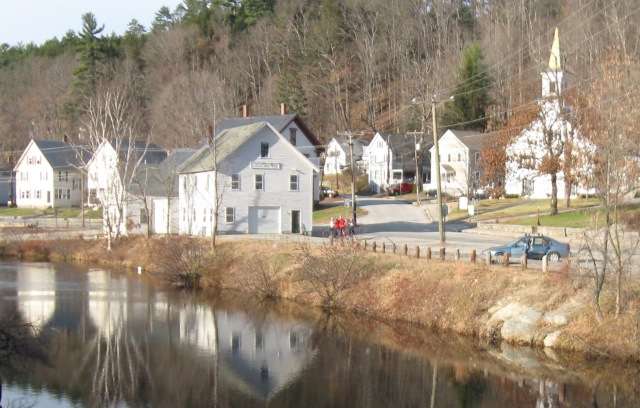The festive raising of the Wilton meetinghouse turned into tragedy in 1773 when a worm-eaten support post gave way. All 53 of the men working on the roof beams fell 27 feet among axes, planks, hammers and crowbars.
The Essex Gazette of Salem called it ‘the most melancholy Accident…that perhaps has been known in the Country.”
Three perished instantly, two died shortly thereafter, two were paralyzed for life and nearly all were crippled or mangled in some way.
A Wilton Meetinghouse
As the American Revolution loomed in 1773, Wilton, N.H., was a frontier town along the Massachusetts border. Chartered as “Salem-Canada” in 1735, soldiers from Salem, Mass., received land for their service in 1690. They fought under Sir William Phips in the first of the French and Indian wars.
New Hampshire Gov. Benning Wentworth regranted the land in 1749, and in 1762 the town incorporated as Wilton.
By 1773, the population of the town reached 580 people — big enough and prosperous enough to build a meetinghouse.
The town selected Ephraim Baker, a master builder, to direct the raising of the Wilton meetinghouse. One hundred twenty men from Wilton and nearby communities volunteered to raise the building. Those who pitched in got a reduction in their property tax.
By Sept. 7, 1775, the sides of the Wilton meetinghouse were all up, and so was a temporary center roof beam. The men would raise the roof that day. Families would come from miles around to watch the spectacle.
Party Planned
The town voted to provide refreshments: a barrel of West India rum, five barrels of New England rum, a barrel of brown sugar, half a box of lemons and two loaves of sugar. Huge amounts of food were also provided for workers and the men, women and children who came on foot and on horseback from neighboring towns.
Bradford gave the orders and men went to work putting up timbers as onlookers enjoyed the show.
The workmen swarmed along the planks that rested on the center beam when a spectator, John Bradford, noticed the middle beam did not have proper support. He saw a worm-eaten post holding it up began to buckle. Bradford then climbed the roof and warned Ephraim Baker, the master workman.
Baker replied he should go home if he felt fearful. Bradford climbed down and started to head for home.
Suddenly he heard a crash. The sound rang in his ears for years after.
Tragedy
The men were raising up the beams and rafters when the frame of the Wilton meetinghouse began to tremble. Men shrank back, the building rocked and suddenly timbers and tools and men collapsed together in a mangled heap.
The Essex Gazette tried to describe the scene:
Upwards of 50 Persons fell to the bottom of the House with the Timber, Boards, Bars, Axes, &c. and exhibited a Scene to the astonish’d Spectators around the House … which can’t be describ’d; and could only be equalled by the Blood and Brains, Shrieks and Groans of the dead and wounded, which were immediately seen and heard…of fifty three that fell now one escap’d without broken Bones, terrible Bruises or Wounds from the Axes, &c. And as they were Men pick’d from that and the neighbouring Towns, and many of them heads of Families, the News of their Catastrophe filled those Places with Weeping, Lamentation and Woe, and my fitly mind us all that “Man knoweth not his time.
A few days later , work began anew on the meetinghouse, dedicated in January 1775. That building burned down, and so the people of Wilton moved the center of town to a more fortuitous location.
A ballad of 43 stanzas was later written to commemorate the Wilton meetinghouse tragedy. It begins,
Attention give and you shall hear
A melancholy theme
Tis such an instance as there is
But very seldom seenIn seventeen hundred seventy three
September seventh day
At Wilton did Almity God
His anger there Display
Photo of Wilton today: By Ken Gallager at en.wikipedia, CC BY-SA 3.0, https://commons.wikimedia.org/w/index.php?curid=17976398
This story was updated in 2022.



5 comments
I wrote about this in my book, “Haunted Hillsborough County.”
[…] via The Wilton Meetinghouse Collapse of 1773 — New England Historical Society […]
[…] tragedy inspired a ballad, The Pickwick Club Tragedy, recorded by Arthur Fields in much as the Wilton Meetinghouse Collapse inspired a ballad 150 years earlier. (You can listen to it […]
“The Meeting House Tragedy” (1998) by Charles E. Clark deals with this unfortunate event. I believe the cover was the last work by UNH artist John W. Hatch.
You told the story well; however the accompanying photo (as of July 2019) is of the modern town center of Wilton, NH, in the valley along the river.
The tragedy occurred in Wilton Center, 2.5 miles away, on a hilltop that was the old town center before the railroad arrived.
A photo of the site of the Second Meetinghouse would show Andy’s Playhouse and the First Unitarian Congregational Society’s church next door.
https://www.wiltonnh.gov/about_wilton/history_of_wilton
http://www.uuwilton.org/history.html
Comments are closed.